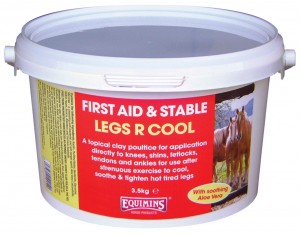How to cool a horse’s legs
Horses involved in strenuous exercise are more susceptible to injury, and the way we care for our horses after exertion can help to prevent issues. Cooling legs after exercise is one part of this. Here, we look at why we cool legs and how to do it.
When horses are working (and, by which we mean strenuous work such as galloping and cross country), the temperature inside the tendon can increase to a point that could be a factor in the breakdown of tendons. What’s more, many people, quite sensibly, put boots on their horse’s legs to help prevent injury from knocks and bumps…but this can actually encourage further heating. Cooling the legs immediately after strenuous exercise can help address the temperature issue and also help to reduce inflammation caused by knocks and bumps.
So, how can you cool your horse’s legs? There are a few options:
- Cooling clays (like Legs R Cool)

- Cooling gels (like Leg Gel)
- Cold hosing (not always practical when at shows)
- Ice/cool boots
Clays can be applied directly to the horse’s skin after exercise and can be bandaged over for additional support, although there is an argument that says bandaging prevents or reduces how effective clay is from a cooling point of view. When the clay is dry, it should be hosed off using cold water, which further helps cooling.
Gels, like clays, can be applied to the skin directly after exercise. Some gels should be used neat and some can be diluted to create a cooling wash. Ingredients vary depending on which brand you use, and can give the gel extra properties. Leg Gel also contains camphor, menthol and allantoin.
Cold hosing involves, as the name suggests, hosing your horse’s legs with cold water. This is good for cooling, but also has the additional advantage of washing the limb and helping to clean any small cuts that may have occurred during ridden work. It is time consuming and can’t really be used with a cooling off regime that involves walking the horse around until his respiration rate reduces.
Cooling boots come in a few different variations – some are plunged into water and then applied whereas some are used with ice packs to help cool. These can be very effective, but you might need additional equipment, such as a way to keep ice packs cool, to make these really work.
Whatever method you use, do keep a careful eye on your horse’s skin to make sure there is no type of reaction. Applying ice directly to the skin can cause issues, and sensitive horses may react to some of the ingredients in some of the clays and gels.
Find out more about our products here.

 Equimins specialises in producing natural horse supplies, products and supplements for the major areas associated with caring for a horse. All products are proudly made in the UK and excellent specification quality products are of paramount importance. Using this blog we want to share some of the knowledge we have gained through nearly 30 years of experience.
Equimins specialises in producing natural horse supplies, products and supplements for the major areas associated with caring for a horse. All products are proudly made in the UK and excellent specification quality products are of paramount importance. Using this blog we want to share some of the knowledge we have gained through nearly 30 years of experience. 


